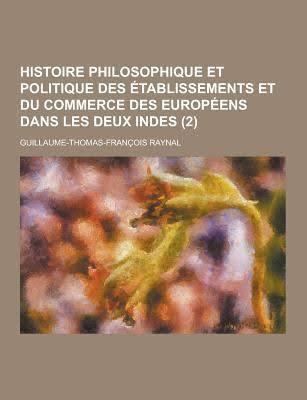Originally published 1770 | Genre Encyclopedia | |
 | ||
Original title Histoire philosophique et politique des établissements et du commerce des Européens dans les deux Indes Working title Histoire des deux Indes Similar Guillaume Thomas François Raynal books, Other books | ||
The Histoire philosophique et politique des établissements et du commerce des Européens dans les deux Indes, more often known simply as French: Histoire des deux Indes ("History of the two Indias"), is an encyclopaedia on commerce between Europe and the Far East, published anonymously in Amsterdam in 1770 and attributed to Abbot Guillaume-Thomas Raynal. It achieved considerable popularity and went through numerous editions. The third edition, published in 1781, was censored in France.
Contents
The Histoire des deux Indes filled a public need for knowledge in the Age of Enlightenment, answering questions that preoccupied the minds of those in the late 18th century, around the time of the French Revolution.
Content
Raynal's idea was to write a history of European enterprises in the East Indies and the New World, having observed the influence of the great explorations on European civilisation.
The book first discusses the Portuguese and their oriental colonies, going on to give a history of British and French enterprises, then Spanish and Dutch, in the Orient. It then turns its attention to European conquests in the Americas, giving an account of atrocities against slaves in New Guinea and presenting a table of French and British colonies in North America, after which there is a series of essays on religion, politics, war, commerce, moral philosophy, belles-lettres, and so on.
Style
The Histoire des deux Indes lacks consistency in its style: Raynal limited himself to collecting articles provided by friends and pieces borrowed from existing published texts, without taking the trouble to rework them.
Authors
Although the book was published anonymously, some authors are known, if only in name.
Proud of his work, Raynal sometimes forgot it was only as good as its contributors made it. This can be seen in the pieces supplied by a Dr Sanchez, the author on Portugal and its possessions in the East and West Indies. Pechméja once found Sébastien-Roch Nicolas de Chamfort reading the Histoire des deux Indes: "What have you found?", he asked. "I have just been reading an excellent piece, but it finishes with such an awful turn of phrase" (French: Je viens de lire un morceau excellent, mais qui se termine par une phrase pitoyable). "Let me see: you're right. I much think that Raynal writes is nonsense; he has added that phrase, the rest is mine". (French: Faites-moi donc voir; vous avez raison. Je pensais bien que Raynal ferait des sottises ; il a ajouté cette phrase, le reste est de moi.) When Raynal left Paris, Chamford said Il est fatigué de vivre avec son auteur ("It is tiring to live with that author").
Reception
The Histoire des deux Indes was a great success. In France, over thirty different editions were published between 1770 and 1787, and over fifty were published abroad. Abridged versions were published called Esprit de Raynal ("Potted Raynal") and Raynal de la jeunesse ("Children's Raynal"). Napoleon Bonaparte proclaimed himself a "willing disciple of Raynal" (French: zélé disciple de Raynal) and took the book with him on his Egyptian campaign. Horace Walpole wrote to Marie Du Deffand: "It attacks all governments and all religions!" (French: Il attaque tous les gouvernements et toutes les religions! Anne Robert Jacques Turgot heavily criticized the book in a letter to André Morellet:
Il est tantôt rigoriste comme Richardson, tantôt immoral comme Helvétius, tantôt enthousiaste des vertus douces et tendres, tantôt de la débauche, tantôt du courage féroce ; traitant l’esclavage d’abominable et voulant des esclaves ; déraisonnant en physique, déraisonnant en métaphysique et souvent en politique. Il ne résulte rien de son livre, sinon que l’auteur est un homme de beaucoup d’esprit, très instruit, mais qui n’a aucune idée arrêtée, et qui se laisse emporter par l’enthousiasme d’un jeune rhéteur. Il semble avoir pris à tâche de soutenir tous les paradoxes qui se sont présentés à lui dans ses lectures et dans ses rêves.
(He is sometimes rigorous as Richardson, sometimes immoral as Helvetius, sometimes enthusiastic of soft and tender virtues, sometimes of debauchery, sometimes of fierce courage ; treating slavery as abominable and willing slaves; deraisonnant in physics, deraisonnant in metaphysics and often in politics. It does not follow anything of his book, if the author is a man of great intelligence, well educated, but has no fixed idea, who is carried away by the enthusiasm of a young rhetorician. He seems to have undertaken the task of supporting all the paradoxes that are presented to him in his lectures and in his dreams.)
At the time, the Histoire des deux Indes was considered an enyclopaedia of the colonial age and the Bible of anticolonialism in the Age of Enlightenment.
In 1780, Raynal produced the third edition of his Histoire philosophique des deux Indes, which was characterised by bolder and more violent tirades than the previous two, and under his signature at the bottom of his portrait he added the inscription: Au défenseur de l’humanité, de la vérité, de la liberté ("In defence of humanity, truth, and freedom").
Louis XVI referred the book to the Parlement de Paris for censorship, and also to the Church. It was banned, and burned by the public hangman on 29 May 1781. Declared a public enemy, Raynal was forced to leave France for Prussia, where he stayed the large part of his exile. He was allowed to return to France in 1787, on condition he did not enter Paris.
